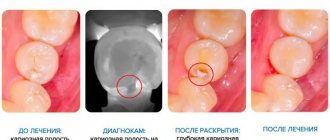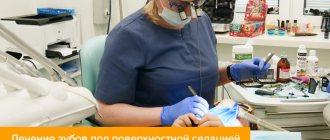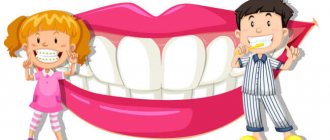Until the age of 7, caries is observed in 80% of cases. This disease begins to develop as soon as teeth erupt. Many parents deliberately do not notice this problem. But practice shows that both baby and permanent teeth need treatment. If the situation is neglected, you can get a purulent infection, pulpitis and other equally serious problems. In addition, treating caries does not necessarily mean drilling. Today, low-penetration techniques have been developed for children. This is fluoridation, silvering, infiltration.
Rules for the treatment of baby teeth
- Anesthesia takes place in 2 stages. This is necessary so that the baby does not feel anything and is not afraid. First, a gel or spray and lidocaine are applied to the gums. Only then is the injection given. For this, the finest needles are used.
- Tissues affected by caries are carefully removed using a special hand tool.
- A safe concentration of anesthetic in the drug is maintained. For Lidocaine it is 2%, for Articaine – 4%. The amount of the drug is selected depending on the weight of the child. Apply from ½ to 1/6 of the standard adult dose. Anesthetics containing adrenaline should not be used for children under 4 years of age.
- Treatment of caries is carried out in sessions. Each should last no more than 30 minutes. Otherwise, the baby will get tired and become capricious.
- Filling materials are used that can be applied in one go. They contain fluoride and other minerals to strengthen teeth.
“Permanent 6th teeth erupt in children aged 5-6 years and, as a rule, are affected by caries first. Teach children how to use toothbrushes and toothpastes correctly, which will prevent plaque from accumulating in deep fissures.”
Rita Martikovna Meliksetyan, Dentist therapist, orthodontist, pediatric dentist, 19 years of work experience
Why you shouldn’t be afraid to treat your child’s teeth
Dentists know about the structural features of baby teeth, so they always use modern painkillers when treating young patients. These products make the treatment painless and comfortable, helping the baby avoid stress.
Thus, in pediatric dentistry today the following anesthesia options are used:
- Local. An affordable and simple way to block the sensitivity of nerve endings. The baby is injected with an anesthetic, due to which the working area becomes completely insensitive. To prevent the small patient from experiencing pain during the injection, the gums are first treated with an anesthetic spray. So, step by step, the doctor ensures that the treatment of caries goes unnoticed for the child.
- Sedation. A progressive option for pain relief. According to its terms, sedative medications are given to the baby to inhale through an inhalation mask. As a result, the patient plunges into an intermediate state between sleep and wakefulness, does not resist the specialist, behaves calmly and does not experience pain.
- General anesthesia. Last resort. It is necessary only if the situation is very serious - the patient categorically refuses to open his mouth and sit still, and the oral disease progresses rapidly and requires emergency treatment. They also resort to anesthesia if the baby is intolerant to all available drugs for local anesthesia. You can’t just use this option for pain relief, as it has a lot of contraindications and side effects.
Parents don't need to worry. Local form of anesthesia is the most common. Usually it is enough to get the baby’s teeth in perfect order. All medications used by dentists when working with children are safe and highly effective. All you have to do is trust the doctor.
How is childhood caries diagnosed?
Tooth decay occurs much faster in children. This process takes several months. All due to weak enamel of baby teeth. They are permeated with many micropores through which bacteria penetrate. Therefore, you need to undergo a dental examination at least once every 3-4 months.
At different stages of caries, its symptoms differ:
- Initial stage. White spots appear on the tooth enamel, which then turn yellow and become rough. There is no pain, although the tooth may react to hot and cold. To eliminate initial damage, you do not need to drill the tooth. In such cases, it is possible to restore the enamel without filling.
- Middle stage. A “hole” is formed at the site of damage to the enamel. Food debris and softened dectin accumulate in it. In such cases, a cavity is formed and a filling is placed to prevent further decay.
- Deep stage. Not only the enamel is destroyed, but also the bone tissue of the tooth. The damage is noticeable to the naked eye. Deep caries can be cured with fillings, but sometimes even this does not help. In some cases, it is necessary to remove a baby tooth.
Diagnosis of carious lesions is carried out visually or using a special probe. If the “hole” is located in a remote place, an oral camera or x-ray is used. In the initial stages of caries, a special composition is used, which is applied to all teeth. It turns the affected areas pink or blue. This method has no side effects.
Gingivitis in children
Another common cause of oral pain in children is gum disease, or gingivitis. The child cannot always determine what exactly caused the pain - the tooth or the gums. Parents should periodically independently examine the child's oral cavity to assess not only the presence of visible cavities, but also the state of the child's oral hygiene. It is the accumulation of a large amount of soft and hard plaque that causes inflammation of the gums, due to the proliferation of pathogenic bacteria in this plaque.
- At what age do baby teeth fall out?
Gingivitis in children
When examining a child’s oral cavity, you can detect gum redness, swelling, and bleeding. All these are signs of gingivitis, which means you need to consult a dentist to make an accurate diagnosis, identify the cause of the disease and prescribe treatment.
Gingivitis can be caused not only by poor oral hygiene, but also by diseases of the child’s internal organs, vitamin deficiencies and endocrine disorders.
Gingivitis
In addition to treatment, it is necessary to adjust the child’s teeth brushing technique, in which both the dentist and parents should help him. You should also discipline your child and motivate him to brush his teeth regularly, not to be lazy and not to skip brushing his teeth.
Table. Features of different forms of gingivitis.
| Form of gingivitis | Child's age | Appearance | Causes |
| Acute traumatic | Any | Red, swollen, painful gums in one limited area | Accidental mechanical trauma to the gums by foreign objects or hard food |
| Chronic catarrhal | Mainly after teething | Red, swollen, painful, and bleeding gums over the entire jaw or both jaws | Poor and irregular oral hygiene, chronic diseases, weak child immunity |
| Chronic hypertrophic | Teenage years | Enlarged, swollen gums, bleeding, discoloration of gums | Incorrect position of teeth, hormonal changes in the body, endocrine disorders |
| Chronic desquamative | Mainly after 6 years, adolescence | Bright red, smoothed gums with signs of atrophy and multiple erosions | Concomitant skin diseases, allergies to personal hygiene products |
Treatment of caries in early childhood
- Fluoridation. The second name of this method is remineralization. This is the saturation of the affected areas of enamel with minerals, its restoration. The tooth surface is treated with a special composition containing calcium, phosphorus, fluorine and other elements. The effect of this treatment lasts for about six months. Fluoridation is indicated for children from 6 years of age.
- Silvering. This method is outdated, but is still sometimes used. The surface of the tooth is coated with a 30% solution of silver nitrate, which destroys bacteria that cause caries. The procedure is absolutely painless. But after it the teeth become black, which can cause complexes in the child.
- Infiltration. A special gel is applied to the affected area of the tooth, which softens the tissue. Afterwards they are washed with an abrasive mixture. The area is then dried and covered with Icon Liquid Filling. The material hardens under a curing lamp.
- Ozone therapy. Ozone under pressure in a gaseous state is applied to the area of the tooth affected by caries. This does not cause any pain. The duration of the procedure is 10-20 seconds. Ozone destroys bacteria that cause tooth decay. After ozone therapy, tooth decay stops.
- Filling. The installation of fillings on baby teeth begins with the removal of dead tissue from the cavity. This is done with hand tools or a drill. The cavity is disinfected with a special composition and hermetically sealed. Upon completion, the surface of the filling is ground.
The filling material should be no harder than enamel. Otherwise, protrusions will form along the edges. Therefore, glass ionomer cements are used for children. They wear evenly and naturally together into enamel.
Some clinics use colored fillings for fillings. They are made from compomer and have no side effects.
How is caries of permanent teeth treated in children?
Caries on permanent teeth is treated as in adults. The main method is filling. Photocomposites are the most successful for sealing the affected cavity. These are materials that do not differ in color or texture from teeth. Filling takes place in several stages:
- Introduction of anesthesia.
- Removing dead tissue using a drill and cleaning the cavity.
- Rinsing the tooth with an antiseptic.
- Air drying.
- Application of phosphate cement insulating gasket.
- Filling with composite materials in several layers, each of which must be dried with a special lamp.
For shallow caries, infiltration, remineralization or ozone therapy can be used. Silver plating is contraindicated.
What should you do if your child has toothache?
If acute pain appears, it is necessary to examine the oral cavity and try to find out the approximate cause of the appearance and nature of the pain, and then give the child an anesthetic that has been approved by a pediatrician specifically for your baby. Under no circumstances should you resort to using remedies recommended by strangers, as each medicine is tolerated differently by individuals and can cause serious complications, including death. Next, you should immediately consult a dentist.
You should not delay treatment, as inflammatory and purulent processes in children develop very quickly, spread to nearby tissues and cause extremely negative consequences.
If a child experiences acute toothache, you should consult a dentist.
If the nature of the pain is unexpressed, periodic, you should schedule a visit to the dentist in the near future as planned. Treatment outside of an exacerbation is better and more effective, so you should not delay seeing a doctor. The health of baby teeth guarantees not only a quiet life for the baby, but also the correct and complete eruption of healthy permanent teeth. After tooth extraction, how long after you can eat, read on our website
Anesthesia for the treatment of childhood caries
Local anesthesia. Used in the vast majority of cases. There are 2 types: application and injection anesthesia. The first does not involve an injection. The risk here is that the child may swallow saliva containing lidocaine. Injections are safer and more effective.
Anesthesia. Used if the child is restless or simply afraid to have their teeth treated. This method is common in the West. Many parents are afraid of memory impairment due to general anesthesia. However, this happens extremely rarely. In addition, general anesthesia becomes the only option when you need to fill several teeth at once in one trip to the dentist. After all, this can take 2 or more hours. Before general anesthesia is administered, the child must undergo the following tests:
- Blood biochemistry.
- General blood and urine analysis.
- Electrocardiography.
- Blood for sugar.
Before the introduction of general anesthesia, you cannot eat for 6 hours, and drink for 4 hours. The child is gently put to sleep using a sedative gas containing sevoflurane. To wake him up, it is enough to increase the oxygen supply. This can be done at any time. After recovery from anesthesia, all reflexes are restored within the first 15 minutes.
Complications of childhood caries
It is important to treat baby teeth. After all, deep caries can penetrate the tissue so much that it damages the permanent dentition. In addition, the condition of temporary teeth subsequently affects the child’s bite. Removal leads to abnormal growth of the jaw. As a result, permanent teeth may appear out of place. Because of this, the child will have to wear braces.
Deep caries leads to inflammation of the pulp, periodontitis, and the formation of basal cysts. Treating these problems is very difficult and painful. It requires root canal filling.
If periodontitis starts, it can cause an abscess and even osteomyelitis. This is already dangerous for the child's life.
How do children's teeth work?
Children have an order of magnitude smaller teeth than adults. In addition, they are much smaller in size than permanent ones, are less durable, and are easily susceptible to the destructive influence of caries.
Pulp - loose fibrous tissue that fills the internal cavity of the tooth - occupies a very large space and is covered with a relatively thin protective layer. It is where blood vessels and nerve endings pass. This means that there are nerves in baby teeth and they can hurt no less than molars.
As for the characteristics of the root system, it is less developed in children than in adults. This is due to the need for root resorption during the period of change of bite .
Dentists never tire of repeating: baby teeth are complex systems in structure, and their condition affects the health of future molars. This is why most people who ignore the need to visit the dentist in childhood have serious dental problems at a young age.
Many parents do not pay enough attention to the health of their children's smiles. They explain their position by the fact that very soon the roots will resolve anyway, and the crown will collapse. But thinking like that is irrational and even dangerous. The inflammatory process can move to the root germ, then there is no need to talk about any healthy change.
Moreover, it is inhumane to deny children dental treatment. Indeed, with severe tissue destruction, they will begin to experience unbearable pain. If you treat caries at an early stage of its development, serious problems are guaranteed to be avoided.
Our patients
Patient recommendations
Akhmedkhanov Said Rashidovich
Dental surgeon, general dentist, implantologist, orthopedic dentist, dental therapist.
Make an appointment 8 (499) 520-98-70
Make an appointment
Recommendations from patient Alekseeva O.V.
Akhmedkhanov Said Rashidovich
Dental surgeon, general dentist, implantologist, orthopedic dentist, dental therapist.
Make an appointment 8 (499) 520-98-70
Make an appointment
Recommendations from patient Zolotareva S.V.
Akhmedkhanov Said Rashidovich
Dental surgeon, general dentist, implantologist, orthopedic dentist, dental therapist.
Make an appointment 8 (499) 520-98-70
Make an appointment
Recommendations from patient Vera
Akhmedkhanov Said Rashidovich
Dental surgeon, general dentist, implantologist, orthopedic dentist, dental therapist.
Make an appointment 8 (499) 520-98-70
Make an appointment
Recommendations from patient Mikhail Ivanovich
Akhmedkhanov Said Rashidovich
Dental surgeon, general dentist, implantologist, orthopedic dentist, dental therapist.
Make an appointment 8 (499) 520-98-70
Make an appointment
Collapse











